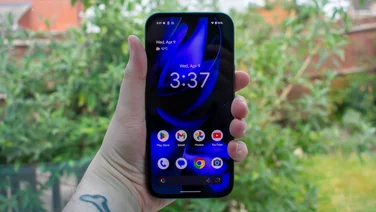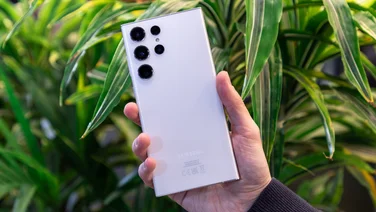To help us provide you with free impartial advice, we may earn a commission if you buy through links on our site. Learn more
























- Thin but robust titanium build
- Bright, vibrant display
- Excellent gaming performance
- Expensive for what it offers
- No telephoto camera
- Small battery
We’ve been seeing rumours of an ultra-thin smartphone from both the Apple and Android sides of the fence for a while now, but the Samsung Galaxy S25 Edge is the first to emerge. We’ll have to wait and see if Apple’s “Air” handset proves to be a viable contender, but for now, the S25 Edge is pretty much unlike anything else in its price range.
In the same breath, however, it feels less complete than the competition in its price range, with no telephoto camera and a notably small battery for its size. So is the skinny build a gimmick that simply isn’t worth these concessions, or is this the first slender step into a brave new world of smartphone design?
Samsung Galaxy S25 Edge review: What you need to know
In context of the rest of the S25 series, the Samsung Galaxy S25 Edge is most closely related to the Galaxy S25 Plus, with roughly the same dimensions in width and height (but not thickness), and an identical 6.7in AMOLED 2X display with a resolution of 1,440 x 3,120 and a dynamic LTPO refresh rate that goes up to 120Hz.
Inside, we have the same Snapdragon 8 Elite for Galaxy chipset used by all the S25 devices, with 12GB of RAM and either 256GB or 512GB or storage space – again, exactly like the S25 Plus.
























Things differ quite dramatically from here, however. Sacrifices were needed to achieve that skinny frame, and first on the chopping block is the battery. The Samsung Galaxy S25 Edge packs a relatively puny 3,900mAh cell – the smallest of the entire S25 line – along with 25W wired and 15W wireless charging.
The other big difference is with the camera set-up. The Samsung S25 Edge lacks a telephoto camera, compensating with a massive 200-megapixel (f/1.7) main camera, alongside the same 12-megapixel ultrawide and selfie cameras found on the Galaxy S25 and S25 Plus.
Price and competition
Despite a couple of downgrades on both the Galaxy S25 and Galaxy S25 Plus, the Samsung Galaxy S25 Edge is more expensive than both, starting at £1,099 for the 256GB model. The 512GB would normally set you back £1,199 but, at the time of writing, you can nab one for the same price as the 256GB version.
























This is very much full-flagship territory, and competition is fierce at this price. The Google Pixel 9 Pro XL, for instance, is currently discounted to £1,019 for the 512GB model, while the 512GB Apple iPhone 16 Plus is reduced down to £1,098.
And then we’ve got some bargain flagship options out of China, with the 512GB Honor Magic 7 Pro costing just £899 and the OnePlus 13 cheaper still, at £863.
Design and key features
Okay, so exactly how skinny is this thing? The Samsung Galaxy S25 Edge measures 5.8mm from front to rear and it weighs an airy 163g. Compared to the S25 Plus (7.3mm thick and 190g), this is a noticeable difference. It’s also the thinnest non-folding phone I’ve ever tested, undercutting the Honor 200 Lite (6.8mm thick) by a solid millimetre.
























I was sceptical about the need for a phone like this leading up to release but, after holding the Samsung Galaxy S25 Edge in my hand, I understand the appeal. Between that slender build and the barely-there weight, the Edge feels wonderfully slight – it’s a welcome change from the parade of chunky flagships that pass across my desk every month, especially the thicker folding phones.
Best of all, that feathery build never feels anywhere close to flimsy or cheap. Quite the opposite, in fact. Samsung has wisely paired the petite frame with the same sturdy titanium as used for the Samsung Galaxy S25 Ultra, making the Edge more robust than the S25 and S25 Plus, both of which use aluminium.
























The Edge also has an IP68 dust and water resistance rating, and there’s Gorilla Glass on the front (Ceramic 2) and back (Victus 2), for scratch and crack resistance.
What you don’t get is the same kind of colour variety as with the rest of the S25 series. My review sample came in silver, and it’s also available in “Icyblue” and “Jetblack” versions. All three look decent enough, but they’re quite muted compared to the “Coralred” S25/S25 Plus or the “Jadegreen” S25 Ultra.
























Just like its siblings, the S25 Edge runs Android 15 out of the box, with Samsung’s OneUI 7 launcher pasted on top. This is still a mildly baffling OS in places – the split notification bar and the app drawer not being organised alphabetically as standard continue to confound me – but it’s generally fluid and accessible. Best of all, Samsung offers seven years of OS updates and security patches for its flagships, keeping the S25 Edge updated until 2032.
Galaxy AI returns here, including the lockscreen Now Bar that debuted earlier in the year with the rest of the S25 series. This feature takes the AI-powered Now Brief feature and gives you a quick rundown of upcoming appointments and weather without having to open your phone. For me, this is about as gimmicky as phone AI gets but it did, at least, work fairly seamlessly in my testing.
Display
The 6.7in AMOLED 2x display is essentially identical to the S25 Plus’ screen, with a razor-sharp 3,120 x 1,440 resolution and a refresh rate that can dynamically adjust between 1Hz and 120Hz. Brightness is just as impressive, too; in manual mode, I recorded a peak of 682cd/m2, while switching to adaptive and shining a torch on the light sensor pushed it to 1,260cd/m2 and HDR content topped out at 1,338cd/m2.
























Colour accuracy was less impressive, but that has clearly not been a priority for Samsung in recent years. With the Natural colour profile selected (measured against the sRGB colour space), I recorded an average Delta E colour variance score of 2.53, which is quite far from the target value of 1 or under. Even still, the screen is vibrant and punchy enough that this shouldn’t affect your viewing experience.
Performance and battery life
Along with death and taxes, another certainty we can rely on is the Snapdragon 8 Elite delivering fantastic performance. The S25 Edge wasn’t quite on par with the S25 Plus in the Geekbench 6 multi-core test – falling around 5% short – but it’s still incredibly nippy, and roughly in line with the Honor Magic 7 Pro and OnePlus 13.
Even more impressive were the GFXBench Car Chase test results, with the S25 Edge hitting a perfect 120fps at native resolution (onscreen) and a very respectable 178fps at 1080p (offscreen). The Honor Magic 7 Pro and OnePlus 13 pushed the Snapdragon 8 Elite a little further with their respective 1080p frame rates, but this is still a fantastic result for the S25 Edge.
In practice, the Samsung Galaxy S25 Edge is a fantastic gamer, too. I ran Genshin: Impact on the highest graphics settings and, even though the app warned me that I could experience some overheating, the phone never got uncomfortably warm, and crucially, gameplay remained smooth and beautifully responsive.
The battery was one of my biggest areas of concern when I first perused the S25 Edge specifications. As it turns out, I needn’t have worried so much. The power efficiency of the Snapdragon 8 Elite is working overtime here but it’s enough to keep the S25 Edge competitive in its price range.
A result of 27hrs 20mins in our standard looping video test isn’t a good enough result to threaten the best in our best phone battery life charts, but it’s still good and broadly in line with the likes of the iPhone 16 Plus and OnePlus 13. In practical use, this should happily see you through a day of moderate screentime without issue.
Charging speeds are relatively slow – 25W falls a long way behind the rapid Honor Magic 7 Pro and OnePlus 13, both of which support 100W fast charging – but the smaller battery means a full charge doesn’t take quite as long as it might have done. Half an hour on charge brought the battery to 55% and it hit 100% after around 1hr 15mins.
Cameras
As much as I had concerns about the battery, I was doubly unimpressed by the lack of a telephoto camera. It’s understandable the skinny frame requires concessions, and telephoto cameras demand physical space, but when even slimmer foldable phones like the Honor Magic V3 (4.35mm unfolded) manage to squeeze in a telephoto shooter, I don’t think Samsung has much of a leg to stand on here.
The 200-megapixel (f/1.7) main camera makes a valiant effort to account for the phone’s shortcomings, producing bright, detailed images with beautiful dynamic range and punchy colours. In short, this is another very accomplished camera from Samsung that will have you taking shots that easily rival the S25 Ultra.

Where the Edge can’t hope to compete with its bigger sibling, however, is zoom photography. With no telephoto camera to speak of, the rear lenses top out at a pitiful 10x magnification. Those 200 megapixels mean that there’s still plenty of detail, even at maximum zoom (below), but when the Ultra – and many other flagships around this price – can go up to 100x, I can’t help but feel disappointed.

Optical image stabilisation on the main lens helps to deliver crisp, detailed low-light images. Colours are natural and even big blocks of darkness are nice and clean – just look at how well defined the overhead cables are against the night sky in this shot:

The 12-megapixel ultrawide camera is the same as the one we saw on the standard S25 and S25 Plus, and it’s still a decent enough shooter. The tone broadly matches the main lens and detail is fine, although obviously the images it produces are nowhere near as sharp as those the 200MP camera serves up. It goes without saying that it would have been better if Samsung had instead included the 50-megapixel ultrawide used on the S25 Ultra.

Video has been especially strong on the S25 series and the Edge is no different in this regard. You can shoot at up to 8K resolution at 30fps, there’s OIS (optical image stabilisation) support up to QHD at 60fps and a 10-bit LOG video mode for those wanting to include the Galaxy Edge in a professional video-production workflow. This an exceptionally well-rounded range of video capabilities and it’s great to see Samsung refusing to compromise in this area.
Samsung Galaxy S25 Edge review: Verdict
Despite that, though, it’s the compromises Samsung has made on camera hardware that ultimately prove the Galaxy S25 Edge’s undoing. The idea of paying over £1,000 for a phone that doesn’t have a telephoto camera and can’t zoom beyond 10x just doesn’t sit right in 2025. Not when phones costing considerably less than this are beginning to include telephoto lenses as standard.
And that’s a shame because, otherwise, the Samsung Galaxy S25 Edge makes a fairly strong case for the skinny phone as an alternative to the mainstream. Performance is excellent, the display is gorgeous and even the battery life, though the weakest of its siblings, isn’t disastrously bad.
If Samsung could have squeezed a telephoto camera in here, I’d be recommending it without question. As things stand, however, as interesting and impressive as the Samsung Galaxy S25 Edge is, I don’t think it’s the version you want to spend your money on. Maybe Samsung will get it right next year.





